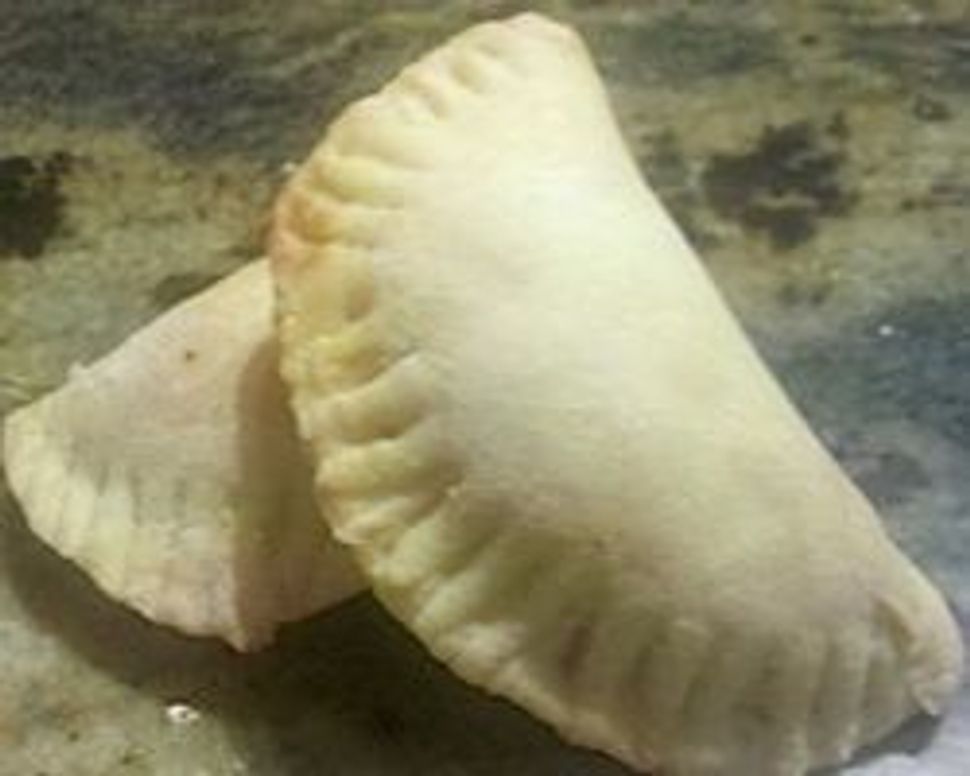When in Rome: Celebrate Shavuot With Italian Foods

Tortelli dolci are stuffed with sweet and creamy ricotta for Shavuot in Italy. Image by Ruth Abusch-Magder
What food goes with fire and brimstone? What do you eat in honor of divine revelation?
These are questions I’ve been pondering lately. The holiday of Shavuot, which starts at sunset tonight, recalls the giving of Torah, that pivotal moment when the people of Israel gathered at Mount Sinai and experienced direct divine revelation. It is pretty heady stuff. But even the most spiritual of moments needs a little food to go with them. Spicy food might seem appropriate, literally embodying the fiery sparks of that fateful day.
Instead, our ancestors went the other way, preferring to capture the symbolic import of the moment with foods that speak to purity of heart and mind that are emblematic of the holiday: dairy foods.
According to some traditional rabbinic sources, dairy was an inevitable choice since the knowledge of how to make meat kosher was not yet revealed. Of course abstaining from killing live creatures is good karmic preparation, too.
Far beyond Jewish tradition, dairy products and other white colored foods have a strong association with purity. As historian Laura Shapiro explains in “Perfection Salad: Women and Cooking at the Turn of the Century,” one of the inaugural banquets for Woodrow Wilson featured an entirely white food menu and even today Americans prefer white chicken meat, which they see as healthier and less animal like than dark meat. And in addition to being a holiday of revelation, Shavuot was historically the holiday of the first harvests in the ancient Israelite agrarian calendar. In addition to the first fruits and grains appearing, new calves are born and milk begins to flow freely from female cows and goats so that they can feed their young. So dairy it is.
For Ashkenazi Jews, coming out of Central and Eastern Europe, dairy on Shavuot translated into blintzes and cheesecake. For North African and Middle Eastern Jews, sambusek, pastries filled in this case with cheese, and milk puddings such as muhallabeya.
But what of Italian Jews? One of the few communities of Jews that are neither fully Ashkenazi nor Sephardi, the Jews of Italy who call themselves B’nei Romi, developed their own religious and culinary traditions over time. Artichokes, for example, which had been discussed in rabbinic sources since ancient times, came to be strongly associated with the Jews of Italian ghettos, only then spreading to tables of non-Jews. This was a community that believed in secular education in addition to religious education. And far before there was confirmation for girls in the United States or the concept of a bat mitzvah, Italian Jews celebrated religious rites for girls.
In a country renowned for food, the culinary traditions of Italian Jews have a long history; they are well developed and sophisticated. Learning from the foodways of the communities in which they lived, Italian Jews embraced ravioli, layered pasta dishes, and braised meats, though they varied the cuisine to follow kosher laws. Despite the upheaval and destruction of the Shoah in Italy, Jewish Italian cuisine has sustained itself andeating it on Shavuot is a revelation of its own.
Italian Jewish Shavuot fare need not be heavy or overly sweet, but it is typically dairy-based. The gnocchi described by Edda Servi Machlin in her book, “Classic Italian Jewish Cooking: Traditional Recipes and Menus” are quite different from the potato dumpling often called to mind by that name. Easy to make, these farina dumplings provide a soft contrast to the flavorful cheesy crust and are delicious served alongside a crisp salad. For dessert, Machlin recommends Tortelli, a light lemon infused cookie whose ricotta filling will fulfill the dairy craving with a well balanced touch of sweetness. I have adapted both recipes here.
By Ruth Abusch-Magder is the Rabbi-in-Residence at Be’chol Lashon and Marissa Weitzman is the Program Coordinator for the Institute for Jewish Community Research.
Tortelli Dolci di Shavuot
Sweet Shavuot Tortelli
Filling:
1 cup ricotta cheese, full fat preferred
¼ cup sugar
1 egg yolk
2 tablespoons candied lemon or orange peel (if you do cannot find it, you can substitute the zest of an orange — preferably organic)
2 tablespoons sliced almond (lightly toasted)
½ teaspoon vanilla extract
Dough:
2 cups pastry flour
2 whole eggs
1 egg separated
3 tablespoons canola oil (or other neutral oil)
2 tablespoons brandy
½ teaspoon salt
½ zest of one lemon (Meyer lemon preferred)
1) Place ricotta cheese in a sieve lined with cheese cloth and drain the liquid until quite dry. At minimum 1 hour but can be left over night in the refrigerator.
2) Preheat oven to 400 degrees.
3) Mix together dough. Flour, 2 eggs and 1 yolk, salt, brandy, oil, and lemon zest.
4) Once the mixture has come together, gently knead the dough for 3-4 minutes. If dough is wet, add a small amount of additional flour. Be careful not to over flour. Dough should be a little sticky. Then let the dough rest for 5 minutes.
5) While dough is resting, make the filling. Gently fold together the ricotta with almonds, ¼ cup sugar, two eggs, 1egg yolk, candied lemon pieces, and vanilla extract. Set aside.
6) Then roll out the dough to about 1/8 of an inch. Cut disks (about three inches across) with either a cookie cutter or a glass.
7) Place a heaping teaspoon of filling in center of each disk. Using reserved egg white, paint edges of disk. Fold each disk in half covering the filling to form a half circle. Seal the edges of each cookie with a fork as you make it. Dough will pull back and shrink if you wait. Place on baking sheet lined with parchment paper.
8) Place in oven for 15 minutes. Until golden brown. Remove from the oven and put on cooling rack. Serve while still warm.
Note: dough and filling can be made ahead of time. Rolled and baked just before serving.
Gnocchi di Semolino alla Romana
Farina Dumplings Roman Style
4 cups whole milk
¾ teaspoon salt
¾ cup unsalted butter
1 1/4 cups farina or slow cook cream of wheat (do not use instant)
1 cup freshly Parmesan cheese
Large handful of fresh basil leaves finely chopped
2 egg yolks
1) Set large saucepan, with milk, salt and 1 tablespoon butter over a low flame. Stir gently until steam begins to rise from the pot. Pour the farina in all at once.
2) Immediately begin to stir vigorously with a whisk for 2 minutes. Remove from heat and stir in half of the remaining butter and half the Parmesan cheese. When the cheese is completely absorbed add in the egg yolk and minced basil. Mix thoroughly.
3) Pour the mixture onto a large cookie sheet (with sides) lined with parchment paper and spread to ½ inch thickness. Work to maintain square shape but do not worry if edges are a little ragged.
4) Place dish in the refrigerator to cool down. Once the gnocchi have cooled completely they will firm up. Preheat the oven to 400 degrees. Melt the remaining butter and spread over dough.
5) Using a pizza cutter or a paring knife cut the edges of the dough to create a smooth line. Then cut the gnocchi into 1 ½ inch squares. Place pieces into rows in buttered 9 x 13 dish. Rows may overlap each other. Drizzle with olive oil and cover in remaining grated cheese. Bake in the oven for 20 minutes, until cheese begins to bubble and brown. Serve warm.























